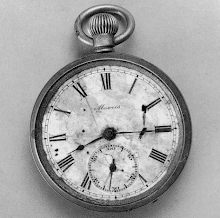a.jpg) At a panel discussion sponsored by Friends of the Earth, community activist Kent Slowinski traces the recent history of attempts to locate and remove chemical weapons buried under Spring Valley ninety years ago. Legacy Project Director, Paul Walker of Global Green USA (far right), looks on as Slowinski shows where Civil War relic hunters recovered World War I munitions next to Dalecarlia Reservoir, the District's water supply.
At a panel discussion sponsored by Friends of the Earth, community activist Kent Slowinski traces the recent history of attempts to locate and remove chemical weapons buried under Spring Valley ninety years ago. Legacy Project Director, Paul Walker of Global Green USA (far right), looks on as Slowinski shows where Civil War relic hunters recovered World War I munitions next to Dalecarlia Reservoir, the District's water supply.
a.jpg)
Partners before "Rick Woods Pit" site visit (2/26/05) ~ USACE
The tour group then walked to the area where Rick Woods entered the
Dalecarlia Woods previously, near the intersection of Rockwood Parkway
and Dalecarlia Parkway. Thomas Jacobus, Washington Aqueduct, met them at
this location and let them on to the property. R. Woods showed the
group the area that he had found Civil War memorabilia years ago and,
after going up a steep incline, located the small gauge railroad bed.
There was a row of rocks there for erosion control and the bed looks
like a walking trail today. Major Verell stated that it is definitely
there and it was R. Woods' landmark for locating the area where he found
munitions previously. The group traveled up a hill, turned east and
went down a hill. R. Woods said this was definitely the area where he
had found munitions. He said he was walking through the woods with a
metal detector, got beeps, brushed some leaves away and started moving
the dirt with a knife to locate the rounds. R. Woods reported that he
began stacking the rounds against a tree and made 6-7 trips to his car,
carrying 6-7 rounds on each trip.
.jpg) Alma Gates, an outgoing Spring Valley-Palisades advisory neighborhood commissioner, took a seat on the advisory board on Nov. 13 after the Army Engineers recommended her. The board serves as a civilian observer of the Army's multiyear cleanup of the chemical munitions buried in the ground during and after World War I, when the area was a military ordnance test site ... [Army Corps Spring Valley project manager Dan] Noble, in an email to [advisory neighborhood commissioner Tom] Smith on Nov. 14, said he was "delighted that Principal Whisenant accepted our recommendation of Alma Gates," whom he called a "steady presence."
Alma Gates, an outgoing Spring Valley-Palisades advisory neighborhood commissioner, took a seat on the advisory board on Nov. 13 after the Army Engineers recommended her. The board serves as a civilian observer of the Army's multiyear cleanup of the chemical munitions buried in the ground during and after World War I, when the area was a military ordnance test site ... [Army Corps Spring Valley project manager Dan] Noble, in an email to [advisory neighborhood commissioner Tom] Smith on Nov. 14, said he was "delighted that Principal Whisenant accepted our recommendation of Alma Gates," whom he called a "steady presence."



.jpg)
.jpg)







.jpg)




a.JPG)
a.jpg)
a.jpg)




.jpg)





a.jpg)

a.jpg)


